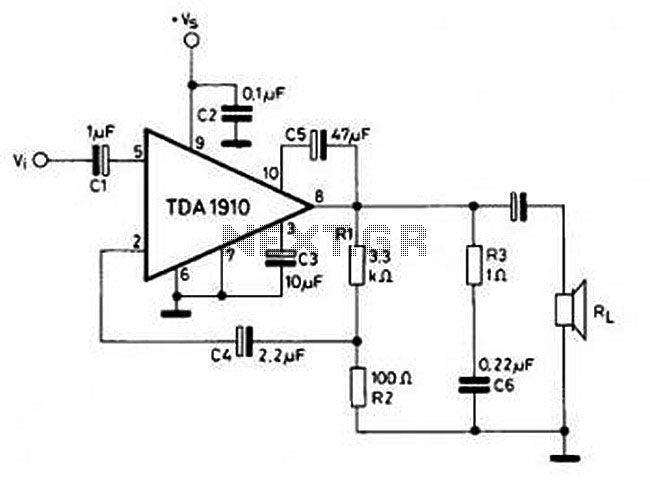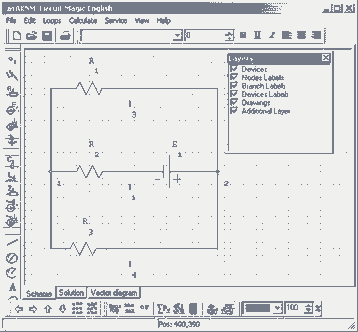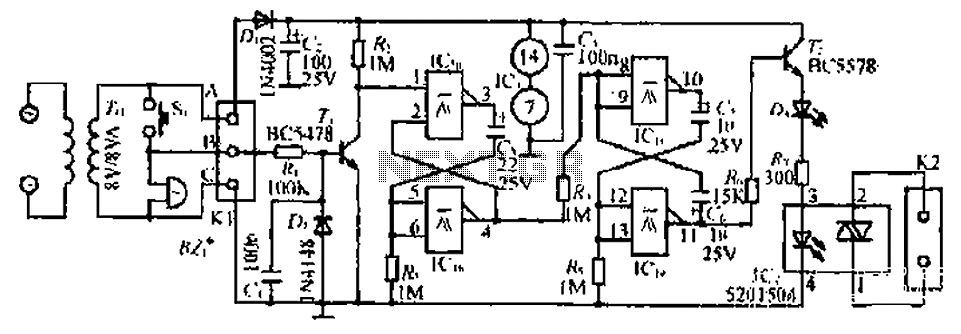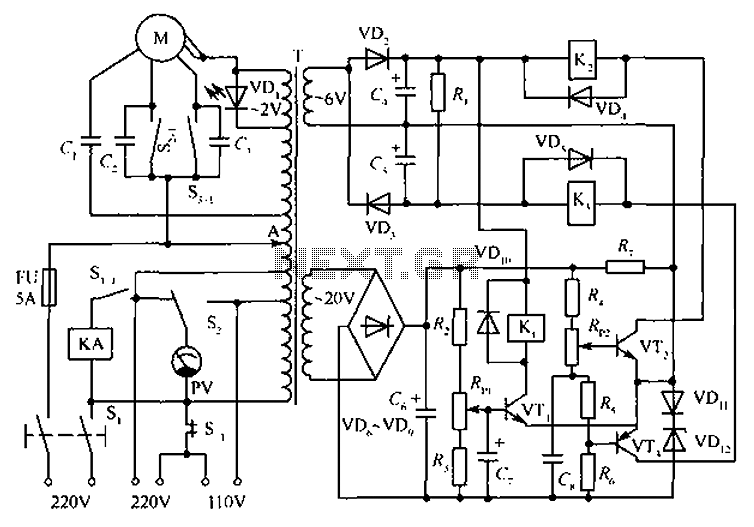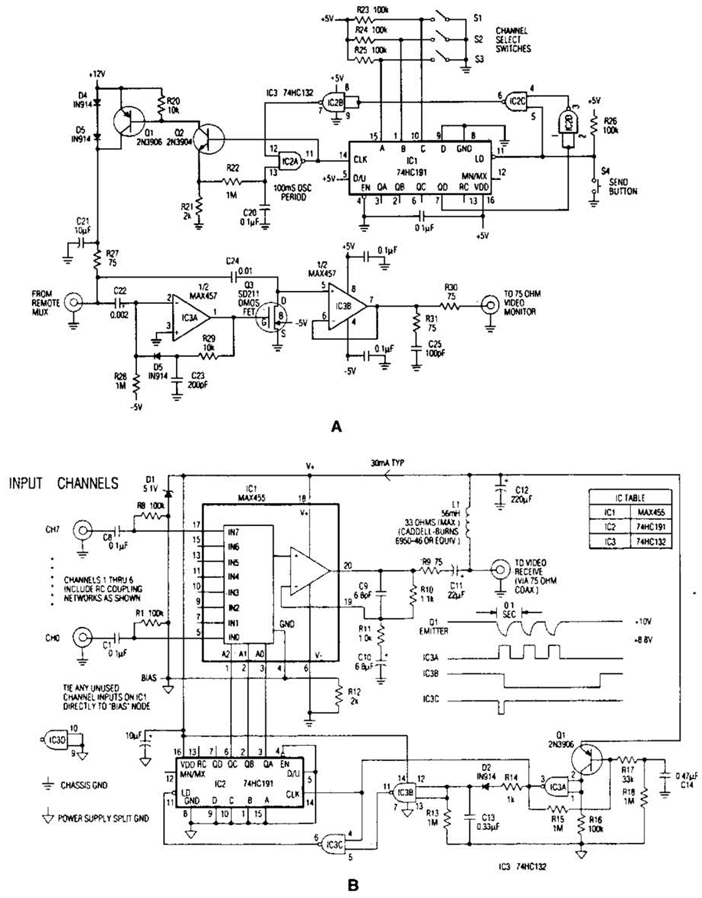
LM1035 36 application circuit
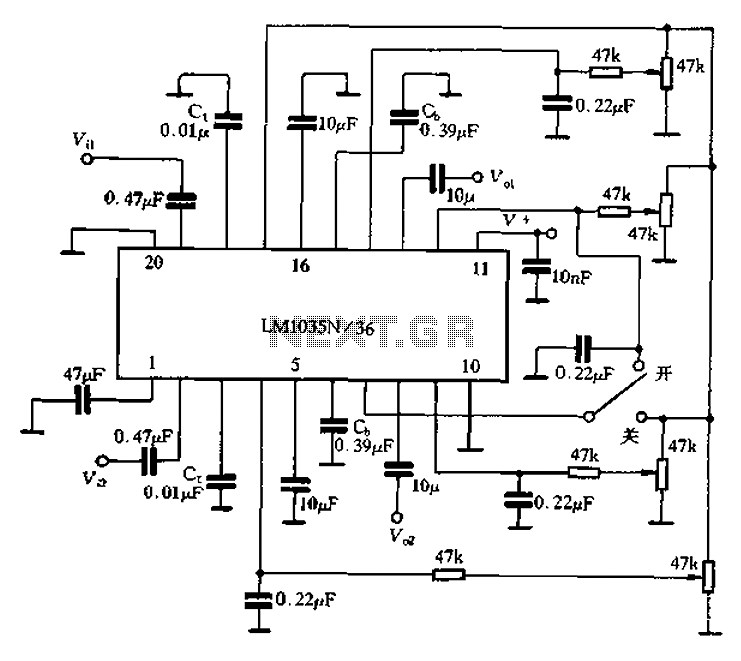
The circuit includes a loudness compensation control terminal at pin 7, which, when combined with the DC control voltage, forms a simple loudness compensation mechanism that enhances bass response. When the loudness control switch is in the OFF position, pins 7 and 17 are connected, resulting in a voltage of 4V at pin V7-5, and the loudness compensation feature is disabled. Conversely, when the control switch is in the ON position, pins 7 and 12 connect, enabling the loudness compensation functionality. Adjustments to the loudness compensation characteristics can be made by changing the capacitance of capacitors Ct or Cb or by altering the voltage at pin 7. Pins 3 and 18 serve as external terminals for a two-channel treble control capacitor, while pin 615 functions as the external terminal for a two-channel bass control capacitor.
The loudness compensation circuit is designed to enhance audio playback by boosting lower frequency sounds, which can be particularly beneficial when listening at lower volumes. The circuit operates based on a straightforward switching mechanism that connects different pins depending on the desired state of the loudness compensation feature.
In the OFF state, the connection between pins 7 and 17 ensures that the circuit does not engage the loudness compensation, maintaining a flat frequency response. The 4V at pin V7-5 indicates that the circuit is effectively bypassed, allowing for standard audio output without any alteration to the bass frequencies.
When the loudness control is activated (ON position), the connection shifts to pins 7 and 12, which engages the loudness compensation function. This activation allows the circuit to process the audio signal differently, enhancing the bass frequencies to provide a richer sound experience. The adjustment of capacitors Ct and Cb is crucial for tailoring the loudness characteristics to the specific requirements of the audio system, allowing for fine-tuning based on user preference or room acoustics.
Additionally, the external treble control capacitor connected to pins 3 and 18 provides flexibility in managing high-frequency response, enabling users to adjust treble levels independently of the loudness compensation. Similarly, the external bass control capacitor at pin 615 allows for further customization of low-frequency response, ensuring that the sound output can be optimized for various listening environments or personal preferences.
Overall, this circuit configuration provides a versatile solution for enhancing audio playback, allowing for both loudness compensation and independent control over treble and bass frequencies.7 feet for loudness compensation control terminal, the foot plus the DC control voltage can be composed of simple loudness compensation, was obtained additional high bass boost . When loudness control switch in the off position (Figure 4-22), 7 feet and 17 feet in contact, then V7-5 4V, loudness compensation does not work; When the control switch in the ON position 7 feet and 12 feet in contact, the availability of loudness compensation. Change Ct or Cb capacity or changing the voltage of 7 feet, can be adjusted loudness compensation characteristics.
3,18 feet are two-channel external treble control capacitor C external terminal; 615 feet are two-channel external bass control capacitor CI) external end.
The loudness compensation circuit is designed to enhance audio playback by boosting lower frequency sounds, which can be particularly beneficial when listening at lower volumes. The circuit operates based on a straightforward switching mechanism that connects different pins depending on the desired state of the loudness compensation feature.
In the OFF state, the connection between pins 7 and 17 ensures that the circuit does not engage the loudness compensation, maintaining a flat frequency response. The 4V at pin V7-5 indicates that the circuit is effectively bypassed, allowing for standard audio output without any alteration to the bass frequencies.
When the loudness control is activated (ON position), the connection shifts to pins 7 and 12, which engages the loudness compensation function. This activation allows the circuit to process the audio signal differently, enhancing the bass frequencies to provide a richer sound experience. The adjustment of capacitors Ct and Cb is crucial for tailoring the loudness characteristics to the specific requirements of the audio system, allowing for fine-tuning based on user preference or room acoustics.
Additionally, the external treble control capacitor connected to pins 3 and 18 provides flexibility in managing high-frequency response, enabling users to adjust treble levels independently of the loudness compensation. Similarly, the external bass control capacitor at pin 615 allows for further customization of low-frequency response, ensuring that the sound output can be optimized for various listening environments or personal preferences.
Overall, this circuit configuration provides a versatile solution for enhancing audio playback, allowing for both loudness compensation and independent control over treble and bass frequencies.7 feet for loudness compensation control terminal, the foot plus the DC control voltage can be composed of simple loudness compensation, was obtained additional high bass boost . When loudness control switch in the off position (Figure 4-22), 7 feet and 17 feet in contact, then V7-5 4V, loudness compensation does not work; When the control switch in the ON position 7 feet and 12 feet in contact, the availability of loudness compensation. Change Ct or Cb capacity or changing the voltage of 7 feet, can be adjusted loudness compensation characteristics.
3,18 feet are two-channel external treble control capacitor C external terminal; 615 feet are two-channel external bass control capacitor CI) external end.
